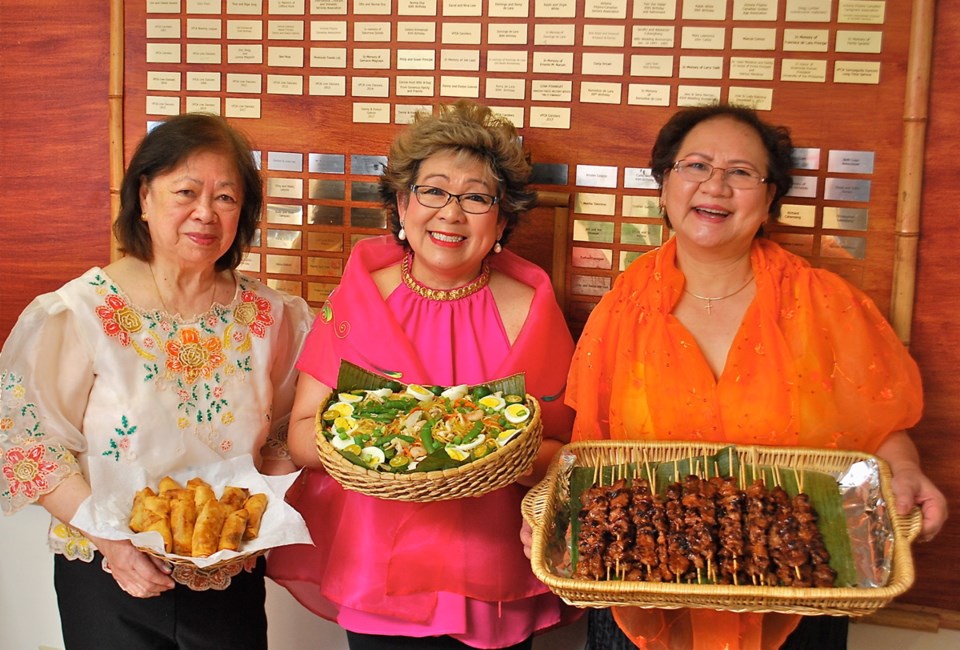Have you ever invited someone over for a special meal and could not decide what to prepare?
That’s how volunteers of Victoria’s Philippine Bayanihan Community Centre — Lorina Miklenic, Norma Duy, Lita Enriquez, Leonor Santos and Connie Custodio — said they were feeling last year around this time, after they invited me there for lunch.
Their goal was to introduce me to some popular Filipino dishes, the kind that might be served at the centre’s Mabuhay event, held every June to mark the anniversary of Philippine independence from Spain. The year’s event will also celebrate the recently introduced Filipino Heritage Month.
It was hard to decide what to serve because Filipino cuisine is quite diverse. Over the centuries, Spanish occupiers greatly influenced the foods served in the Philippines — as did immigrants from other countries, such as Malaysia, China, Japan and India. Add in dishes already enjoyed in the Philippines, and unique, local ingredients, and it’s easy to understand why the menu of foods eaten there is so deliciously varied.
For that lunch last year, Miklenic and the other volunteers finally settled on chicken adobe, a Spanish-influenced creation where pieces of the bird are marinated with such things as vinegar, soy sauce and garlic, before being braised. They also dished up ginataang gulay, a Southeast Asian-influenced vegetable dish simmered in coconut milk.
Both dishes were divine. But at the end of the meal, the volunteers insisted I come back to try other Filipino dishes they wished they had served me that day.
I finally did. This time, the volunteers, who this year included Lucy Scott, had prepared four dishes for me to try. They included succulent, smoky, sweet-and-salty-tasting Filipino-style barbecue pork skewers, and pancit, a fabulous noodle dish rich with shrimp and chicken. They also served ukoy, a type of fritter strewn with several types of vegetables and tofu. For dessert, they made turon, a crispy, banana-filled egg roll that also had jackfruit in it. That lunch was a feast — everything was incredibly flavourful.
If you would like to try some of the dishes I enjoyed and others, check out the Philippine Bayanihan Community Centre’s Mabuhay event, which takes place Saturday, June 15, from 10 a.m. to 6 p.m., in Victoria’s Centennial Square.
Admission is free and during the day there will be activities for all ages, including games, exhibits and a program on stage, with singing and performances by the award-winning Sampaguita Dancers. There will also be three stations selling a wide array of Filipino-style foods, in single servings and combination plates, both savoury and sweet.
Organizers of the event say “Mabuhay” is derived from “buhay,” a Filipino word that means life and is used to express welcome, congratulations and good wishes.
To learn more about the Philippine Bayanihan Community Centre and Mabuhay, go to bayanihan.ca.
Filipino-style Barbecue Pork Skewers
This recipe is adapted from a dish given to me by volunteers of Victoria’s Philippine Bayanihan Community Centre. It yields nicely charred, succulent, richly flavoured pork that smells amazing as it cooks. Serve the skewers on their own as an appetizer, or as a main dish with rice or noodles and vegetables.
Preparation time: 30 minutes, plus overnight marinade
Cooking time: About 10 minutes
Makes: Six (two skewers each) servings
1/2 cup brown sugar
1/2 cup ginger ale
1/2 cup barbecue sauce
1/4 cup banana sauce (Filipino-style ketchup, see Note 1)
1/4 cup oyster sauce
1/4 cup minced garlic
• hot chili sauce, to taste (optional)
2 1/4 lb (about 1 kg) pork shoulder roast or steaks, cut into 1/2-to 1-inch cubes
• vegetable oil for the grill
In a bowl large enough to hold the pork, make marinade by combining sugar, ginger ale, barbecue sauce, banana sauce, oyster sauce, garlic and hot chili sauce, if using. Scoop out 1/2 cup of the marinade, set in a smaller bowl, cover and refrigerate until needed.
Add the pork to the marinade in the larger bowl and toss to coat. Cover, refrigerate and marinate the pork overnight.
When fully marinated, divide and skewer the cubes of pork onto 12, nine-inch or longer metal or wooden skewers (see Note 2).
Preheat a barbecue or indoor grill to medium-high. Lightly oil the bars of the grill. Grill the pork skewers four minutes, then turn each one over. Brush the skewers with some of the reserved marinade in the small bowl.
Cook skewers four minutes more, turn each one over again, then brush with some more of the reserved marinade. Cook skewers two to three minutes more, turning occasionally, if needed, or until cooked through (see Note 3), and then serve.
Note 1: Banana sauce is red-hued Filipino-style ketchup. You’ll find it at some grocery stores with a well-stocked Asian foods section, and at Filipino food stores. I bought it in Victoria at Casa Philippine Convenience Store, 1483 Douglas St.
Note 2: If using wooden skewers, to help prevent them from scorching, soak them in cold water at least an hour before skewering the pork.
Note 3: When cooked, the pork will feel firm, but still have a little give. If it’s very or somewhat soft, the pork is not cooked. If it’s very firm, it’s overcooked.
Eric Akis is the author of eight cookbooks. His columns appear in the Life section Wednesday and Sunday.



